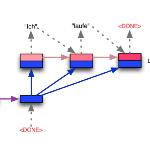The paper studies the capabilities of Recurrent-Neural-Network sequence to sequence (RNN seq2seq) models in learning four string-to-string transduction tasks: identity, reversal, total reduplication, and input-specified reduplication. These transductions are traditionally well studied under finite state transducers and attributed with varying complexity. We find that RNN seq2seq models are only able to approximate a mapping that fits the training or in-distribution data. Attention helps significantly, but does not solve the out-of-distribution generalization limitation. Task complexity and RNN variants also play a role in the results. Our results are best understood in terms of the complexity hierarchy of formal languages as opposed to that of string transductions.
翻译:本文研究了经常性神经网络序列序列(RNNN supps2seq)在学习四种从字符串到字符串转换任务(身份、逆转、全面重复和输入指定的重复)模型的能力。这些转换传统上都是在有限的国家传感器下研究的,其性质复杂程度各不相同。我们发现,RNN 后世2seq模型只能接近与培训或分布数据相匹配的绘图。注意大有帮助,但不能解决分配外的通用限制。任务复杂性和RNN变量也在结果中发挥作用。我们的结果最能从正式语言的复杂性等级而不是字符串转换的角度来理解。</s>




